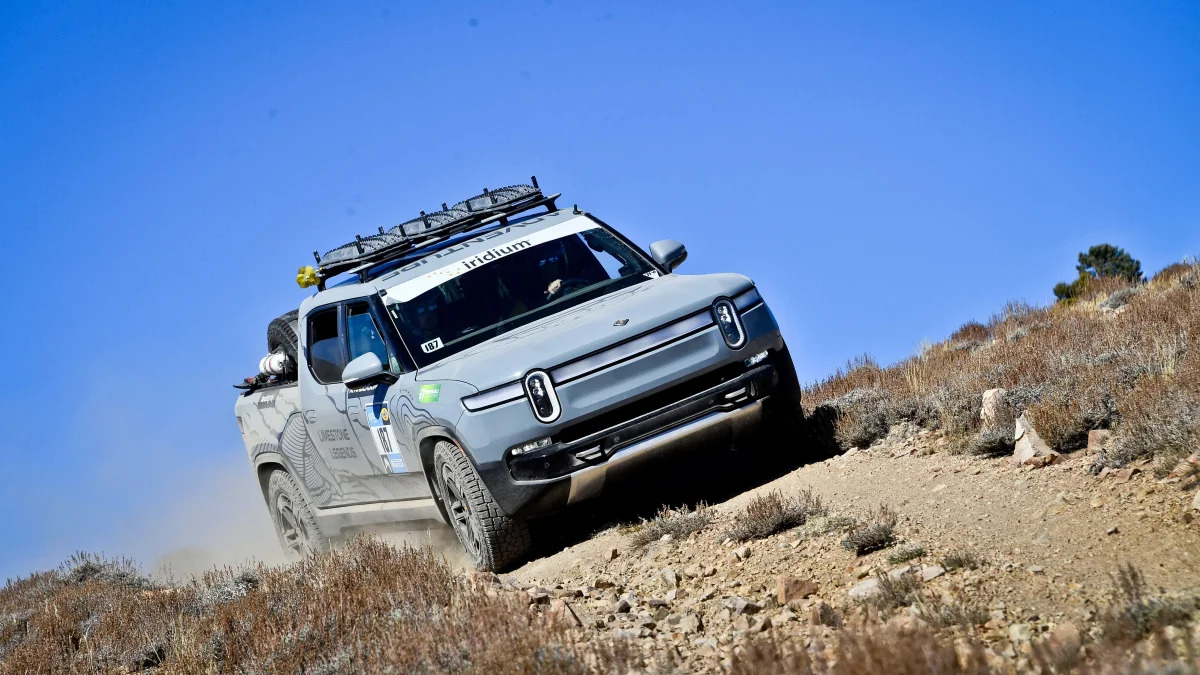For the first time ever, a fully-electric battery vehicle has taken the crown at the Rebelle Rally. The 2023 Rivian R1T crossed the finish line this past weekend in first place with Lily Macaruso behind the wheel and navigator Alex Anderson sitting in the right seat.
The Rebelle Rally is a seven-day navigational competition where teams of two drive street-legal cars and trucks off-road for over 2,000 kilometers using only analog navigation tools. Teams must use a scale ruler and a plotter to mark a series of checkpoints on a topographical map. They then drive to those checkpoints using just a compass. It is not a race for speed, but a rally for navigational accuracy. There are no chase crews, no phones and no GPS.
Also, there are no men.
Yes, the Rebelle is meant only for women. Founder Emily Miller wanted to give women a place to compete even if they have little to no experience. While some teams have a motorsports background, many are lawyers, engineers, moms, entrepreneurs or journalists. The only requirement is that they demonstrate a basic understanding of driving and navigating.
In 2020, yours truly along with my navigator Rebecca Donaghe spearheaded the Electrified class, bringing the very first Rivian R1T off the production line. For two years we beta-tested the program as the Rebelle brought Renewable Innovations on as charging partners. In 2022 Rivian sent two vehicles with employees behind the wheel. Macaruso and Anderson earned the coveted Rookies of the Year award and a fourth-place finish that year. 2023 was their time to take it to the next level.
Driver Marcuso is senior special projects engineer at Rivian. In 2019, she navigated for Miller in the Carta Rally in Morocco, taking the class win. After working on the crew for the Rebelle Rally, she joined as a competitor in 2022, leading to her overall 4x4 win in 2023.
“Winning first place in the 4x4 class was a byproduct of Alex and my efforts,” says Macaruso. “We set goals and agreements of what we wanted together…and no matter how hard the challenge, it was us against the problem, not against each other. When you have a great teammate, an amazing vehicle, support of a community, and unbreakable driving spirits- how could we be anything but successful?”
Navigator Anderson, meanwhile, is a senior mechanical engineer and works on the body exterior team at Rivian. While the Rebelle is her only formal motorsports experience, Anderson has been wheeling dirt bikes and trucks for most of her life. This year she found the navigation to be an especially demanding task.
“This year was a new twist of constant navigation challenges,” says Anderson. “We had the time crunch as usual, but on top of that, we had so many new elements thrown at us. We had to navigate heavily wooded forests. One day we were handed a map with so few features it might as well have been blank and had to rely only on dead-reckoning– traveling on a consistent heading– to find the checkpoints. For the two-day marathon stage in Johnson Valley, California, we received a list of 48 checkpoints we could hunt in any order, bringing strategy and time management to the forefront. We also had checkpoints in a new area of the Glamis dunes that most of us had never been yet alone navigated. Each day presented new and unique challenges for us Rebelles.”
Charging in remote locations
The Rivian R1T’s win would not be possible without the rally’s partnership with Renewable Innovations and its Mobile Energy Command-Hydrogen trailer, or MEC-H. The Utah-based company brought green hydrogen – made with renewable power like solar and wind – out to the remote base camps, starting near Mammoth, California, and ending in the largest dunes in North America, the Imperial Sand Dunes in Glamis, California.
This clean hydrogen powered up a total of four R1T trucks, an equal number of PHEV Jeep Wrangler 4xe rigs, as well as one Ford Mustang Mach-E Rally. Each night the BEVs were packed with electrons to a 100-percent state of charge. While that isn’t recommended for everyday driving, with days consisting of up to 490 kilometers, the electric vehicles needed all the charge they could get.
However, some days required on-course charging,– as well as on-course fueling for the ICE vehicles. On these days the MEC-H, with its eight fuel cells, was waiting for the electric vehicles in a key location. The BEV rigs had four opportunities to charge on-course throughout the rally, with day 6 being the biggest nail-biter for Marcuso and Anderson. They arrived with a mere 8-percent state of charge. After 65 minutes and 85.8 kWh, the R1T left with a 68-percent state of charge thanks to the DC fast chargers in the MEC-H.
Dune driving and charging
The only day that the Rebelle Rally offered on-course charging without offering the equivalent for ICE vehicles was on day 7 in the dunes of Glamis. The course Miller had plotted out that day was about 113 kilometers.
“Based on the kWh consumption that we have seen in the past in the dunes, you’d use 160 kWh of battery,” says Miller. “None of our EV competitors had that range. The ICE vehicles could achieve 8-12 kpg in their vehicles, and had fuel tanks large enough to complete the course.”
On day 7 Macaruso and Anderson stopped for a charge around noon before continuing on to get 82-percent of that day’s points. They crossed the finish line under the blazing sun having earned a first-place finish as well as the Bone Stock award for the highest-placing team in a vehicle with no modifications and the Pirelli Tire Contingency Award for the highest-placing team running the Pirelli Scorpion A/T tires.
The Rebelle Rally takes place every year in October. Women who would like to sign up can do so at www.rebellerally.com. Be advised that spaces fill up quickly.










Sign in to post
Please sign in to leave a comment.
Continue